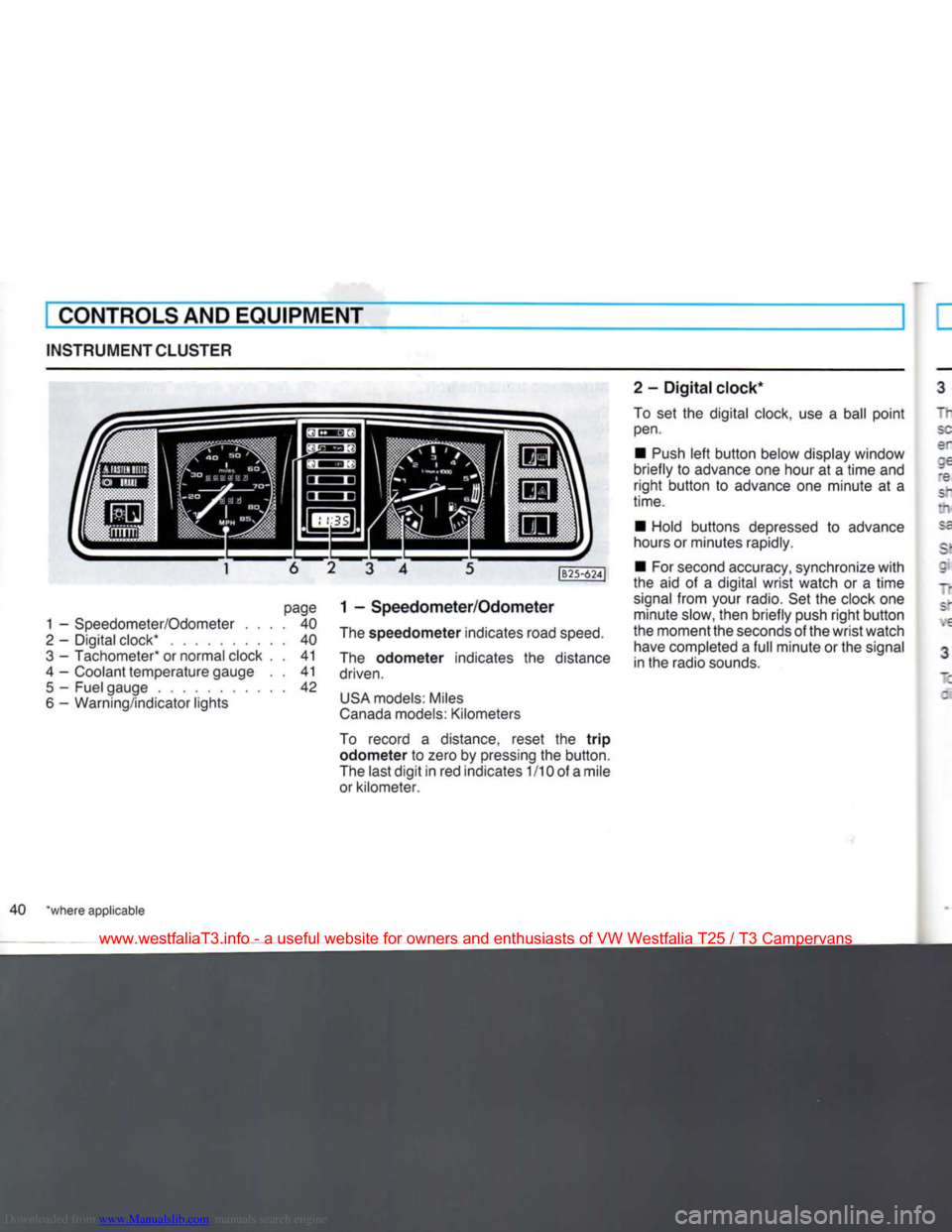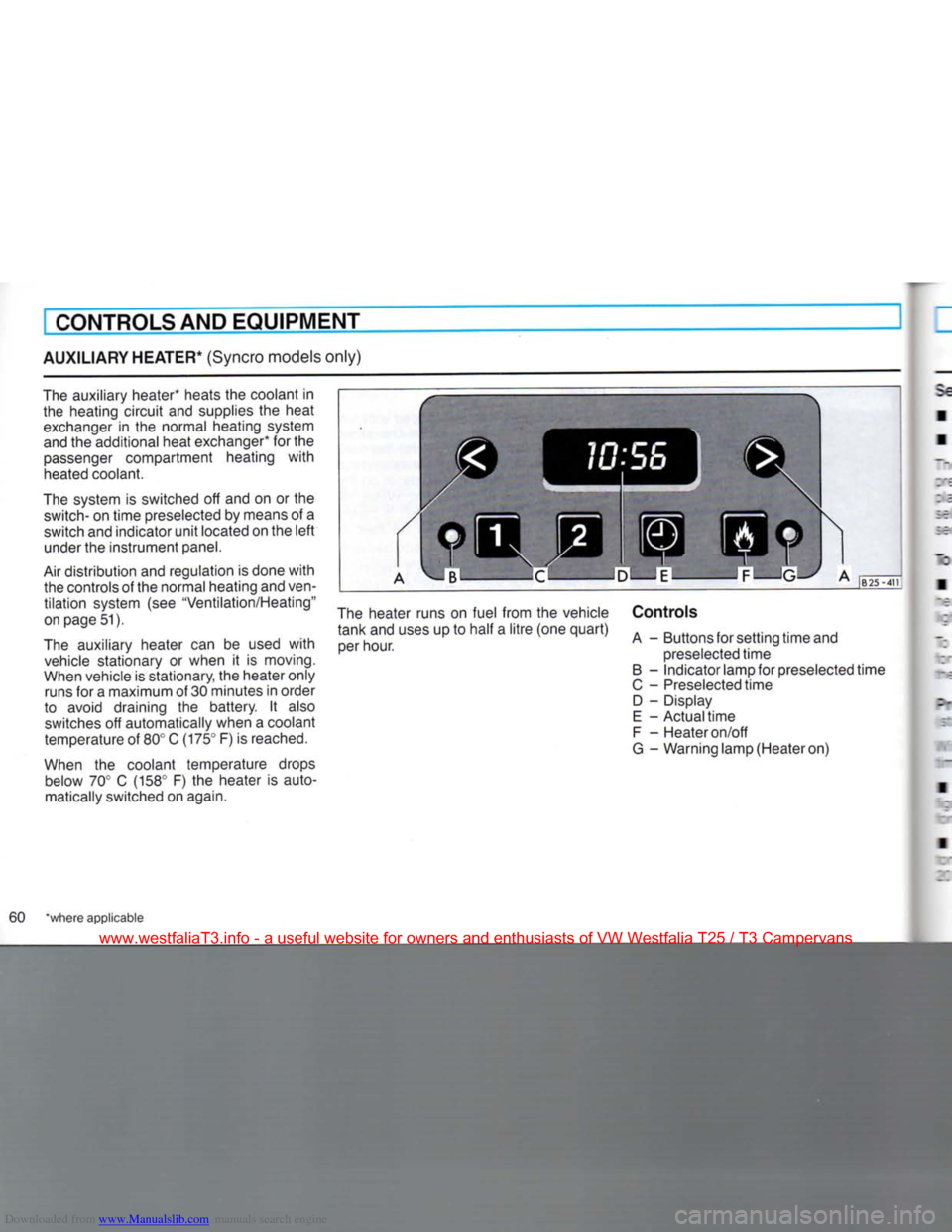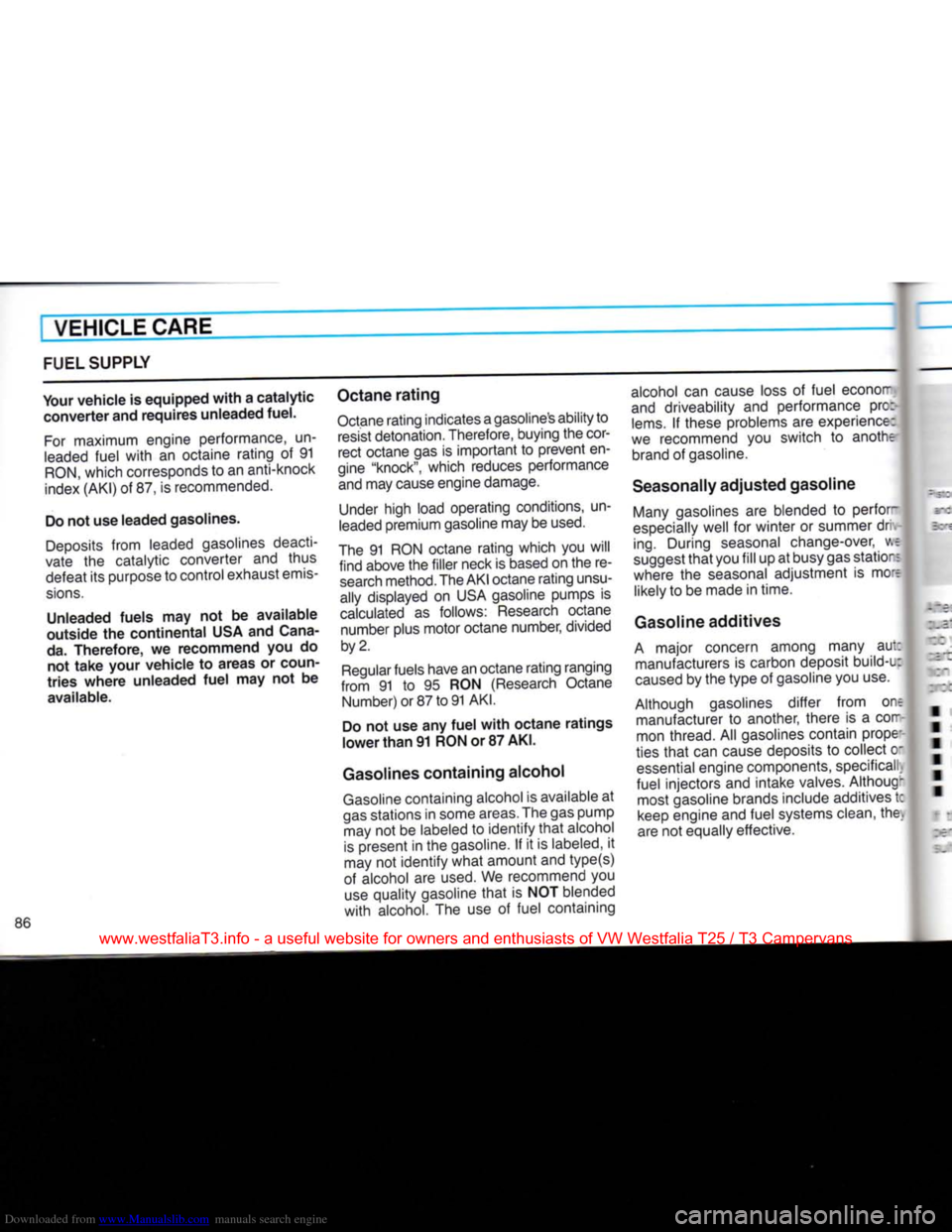1990 VOLKSWAGEN TRANSPORTER display
[x] Cancel search: displayPage 41 of 165

Downloaded from www.Manualslib.com manuals search engine
CONTROLS
AND
EQUIPMENT
INSTRUMENTCLUSTER
page
1 -
Speedometer/Odometer
.... 40
2
-
Digital clock*
40
3
-
Tachometer* or normal clock
. . 41
4
-
Coolant temperature gauge
. . 41
5
-
Fuel gauge
42
6
-
Warning/indicator lights
|B25-624J
1 -
Speedometer/Odometer
The
speedometer
indicates road
speed.
The
odometer
indicates
the
distance
driven.
USA
models: Miles
Canada
models: Kilometers
To record
a
distance, reset
the
trip
odometer to
zero by pressing the button.
The last
digit
in red indicates
1
/10 of a mile
or kilometer. 2
-
Digital
clock*
To
set the
digital clock, use
a
ball
point
pen.
•
Push
left
button
below display window
briefly
to
advance one hour
at a
time
and
right
button
to
advance
one
minute
at a
time.
•
Hold buttons depressed
to
advance
hours or minutes rapidly.
•
For second accuracy, synchronize
with
the
aid of a
digital
wrist
watch
or a
time
signal
from
your radio. Set the clock one minute slow, then briefly push
right
button
the moment the seconds of the
wrist
watch have completed a
full
minute or the signal
in the radio sounds.
40 *where applicable
www.westfaliaT3.info - a useful website for owners and enthusiasts of VW Westfalia T25 / T3 Campervans
Page 61 of 165

Downloaded from www.Manualslib.com manuals search engine
I
CONTROLS AND EQUIPMENT
AUXILIARY HEATER* (Syncro models only)
The auxiliary heater* heats the coolant in the heating circuit and supplies the heat exchanger in the normal heating system
and the additional heat exchanger* for the
passenger compartment heating with heated coolant.
The system is switched off and on or the
switch-
on time preselected by means of a
switch and indicator unit located on the left under the instrument panel.
Air distribution and regulation is done with the controls of the normal heating and
ven
tilation system (see "Ventilation/Heating"
on page 51).
The auxiliary heater can be used with vehicle stationary or when it is moving.
When vehicle is stationary, the heater only runs for a maximum of 30 minutes in order
to avoid draining the battery. It also switches off automatically when a coolant
temperature of 80° C (175° F) is reached.
When the coolant temperature drops below 70° C (158° F) the heater is automatically switched on again. The heater runs on fuel from the vehicle
tank and uses up to half a litre (one quart) per hour. Controls
A - Buttons for setting time and
preselected time
B - Indicator lamp for preselected time
C - Preselected time D - Display
E - Actual time
F - Heater on/off
G - Warning lamp (Heater on)
60 "where applicable
www.westfaliaT3.info - a useful website for owners and enthusiasts of VW Westfalia T25 / T3 Campervans
Page 62 of 165

Downloaded from www.Manualslib.com manuals search engine
CONTROLS AND EQUIPMENT
Setting
the
time
•
Press
and hold clock button E.
• Set clock
with
buttons A.
The
display lights up as long as button is
oressed.
When button is released the dis
play goes out or, if a time has been pre
selected,
the selected time lights up for 2
sees.
To
switch
heater
on or off • This is done by pressing button
F.
When
-eater is switched on the warning lamp G ghts up.
To
ensure
that
the heater starts the lever ;or the heat output must be pushed fully to
:ie
right.
This
closes
an electrical contact.
Preselecting
starting
time
for
heater
stationary operation, ignition off)
With buttons C two different switch-on
:imes
can be selected within 24 hours.
•
Press
and hold button. The appropriate
*:gure 1 or 2 appears in display. The ready- •or-action lamp lights up.
• Set required switch-on time
with
but
tons A. The display remains on for about 20 seconds after releasing button C.
To
ensure
that
the heater starts up at the
selected
time, the lever for the heat output must be pushed fully over to the
right.
In
addition to this the blower must be
switched to Stage 1. On account of the higher current consumption, a higher
stage
should only be selected in isolated
cases.
Switching
preselected
time
off • The preselected time can be switched
off by briefly pressing the appropriate but
ton C. The ready-for-action lamp and the figure in display then go out.
Fuses
The
fuses for the auxiliary heater are in an additional holder behind the main fuse
box.
Notes
• Every time the heater is switched off,
the warm air and combustion air blowers
continue running briefly to cool the heater
down quicker.
• To avoid draining the battery, do not run
the heater repeatedly when the engine is not running.
• When driving through mud and snow,
the exhaust pipe may tend to get blocked.
Have
a look at it occasionally to see
that
it
is
clear.
WARNING
Never
start
the
heater
or let the
engine
or the
heater
run in an enclosed,
unventilated
area.
Exhaust
fumes
from
the
engine
or the
heater
contain
carbon monoxide,
which
is colorless and odor
less.
Carbon monoxide,
however
is a
very
harmful
gas, and may be
fatal
if in haled.
Due to the
risk
of
fire
the
heater
must
not be used
when
vehicle
is
parked
on
dry grass, brush or leaves.
www.westfaliaT3.info - a useful website for owners and enthusiasts of VW Westfalia T25 / T3 Campervans
Page 91 of 165

Downloaded from www.Manualslib.com manuals search engine
VEHICLE CARE
FUEL SUPPLY
Your vehicle is equipped with a catalytic converter and requires unleaded fuel.
For maximum engine performance, un
leaded fuel with an octaine rating of 91
RON,
which corresponds to an anti-knock
index (AKI) of 87, is recommended.
Do not use leaded gasolines.
Deposits from leaded gasolines deacti
vate the catalytic converter and thus
defeat its purpose to control exhaust emis
sions.
Unleaded fuels may not be available
outside the continental USA and Cana
da.
Therefore, we recommend you do not take your vehicle to areas or coun
tries where unleaded fuel may not be
available. Octane rating
Octane rating indicates a gasoline's ability to
resist detonation. Therefore, buying the cor
rect octane gas is important to prevent en
gine "knock", which reduces performance and may cause engine damage.
Under high load operating conditions, un
leaded premium gasoline may be used.
The 91 RON octane rating which you will find above the filler neck is based on the re search method. The AKI octane rating unsu-
ally displayed on USA gasoline pumps is
calculated as follows: Research octane number plus motor octane number, divided
by 2.
Regular fuels have an octane rating ranging
from 91 to 95 RON (Research Octane Number) or 87 to
91
AKI.
Do not use any fuel with octane ratings
lower than 91 RON or 87 AKI.
Gasolines containing alcohol
Gasoline containing alcohol is available at
gas stations in some areas. The gas pump may not be labeled to identify that alcohol
is present in the gasoline. If it is labeled, it
may not identify what amount and type(s)
of alcohol are used. We recommend you
use quality gasoline that is NOT blended
with alcohol. The use of fuel containing alcohol can cause loss of fuel econorr
and driveability and performance pre:
lems.
If these problems are experience:
we recommend you switch to anothe brand of gasoline.
Seasonally adjusted gasoline
Many gasolines are blended to perfor-
especially well for winter or summer drl
ing.
During seasonal change-over, wl
suggest that you fill up at busy gas statior I
where the seasonal adjustment is mo-r likely to be made in time.
Gasoline additives
A major concern among many aut: manufacturers is carbon deposit build-i:
caused by the type of gasoline you use.
Although gasolines differ from onr manufacturer to another, there is a cor-
mon thread. All gasolines contain props'
ties that can cause deposits to collect ad essential engine components, specificali
fuel injectors and intake valves. Althoug- most gasoline brands include additives tc
keep engine and fuel systems clean, the;,
are not equally effective.
www.westfaliaT3.info - a useful website for owners and enthusiasts of VW Westfalia T25 / T3 Campervans